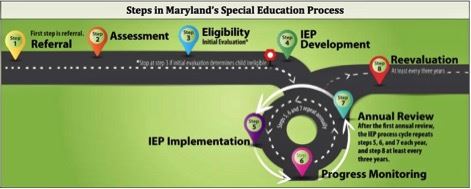xMinds events, resources and services are always FREE |
About IEPs: The IEP Road Map | FAQs | Parent Guidance | Abbreviations | Dispute Resolution | Accommodations | Related Services |
Navigating the IEP ProcessClick here to read helpful guidance for parents navigating the IEP process. Disclaimer: The material provided here is for general informational purposes only and not for the purpose of providing legal advice. You should contact your attorney to obtain advice with respect to any particular issue or problem.
Step 1 - ReferralIf you or your child’s teacher suspects your child has a disability and may need special education services, you or the teacher may make a written referral to your child’s school. This referral will prompt a Screening Meeting, where the IEP team will review the referral and any other helpful information to determine whether your child should be tested or “assessed.” Step 2 - AssessmentIf assessment is required, the school will test your child in all areas of suspected disability. If your child is found to be eligible for services (Step 3), information obtained from these tests will assist the IEP team in creating your child’s IEP and selecting the appropriate services and supports (Step 4). Step 3 - EligibilityWithin 60 days of your consent to testing, the IEP team holds an Initial Evaluation Meeting to review the results of testing and to determine whether your child falls within any of the 14 categories of disability that qualify a child to receive special education services under IDEA. Step 4 - IEP DevelopmentIf the IEP team determines that your child is eligible for special education services, it must meet within 30 days of the Initial Evaluation Meeting to develop a program of services based on your child’s needs, and incorporate them into a written IEP document. This is the Initial IEP Meeting. Step 5 - IEP ImplementationAs soon as possible after the Initial IEP Meeting your child should receive the services listed in the IEP. Each of your child’s service providers must have a copy of the IEP and be informed of their responsibilities as specified in it. Step 6 - Progress MonitoringYou will be informed of your child’s progress toward meeting the IEP’s annual goals as often as a parent of a non-disabled child is informed of their child’s progress. Step 7 - Annual ReviewThe IEP team reviews your child’s IEP at least annually, including a review of progress toward annual goals, results of any reevaluations, any anticipated needs, or other matters, and revises the IEP as appropriate. Step 8 - ReevaluationThe IEP team reevaluates your child’s eligibility for special education services at least every three years. The reevaluation may involve new testing. |
About IEPs: The IEP Road Map | FAQs | Parent Guidance | Abbreviations | Dispute Resolution | Accommodations | Related Services

